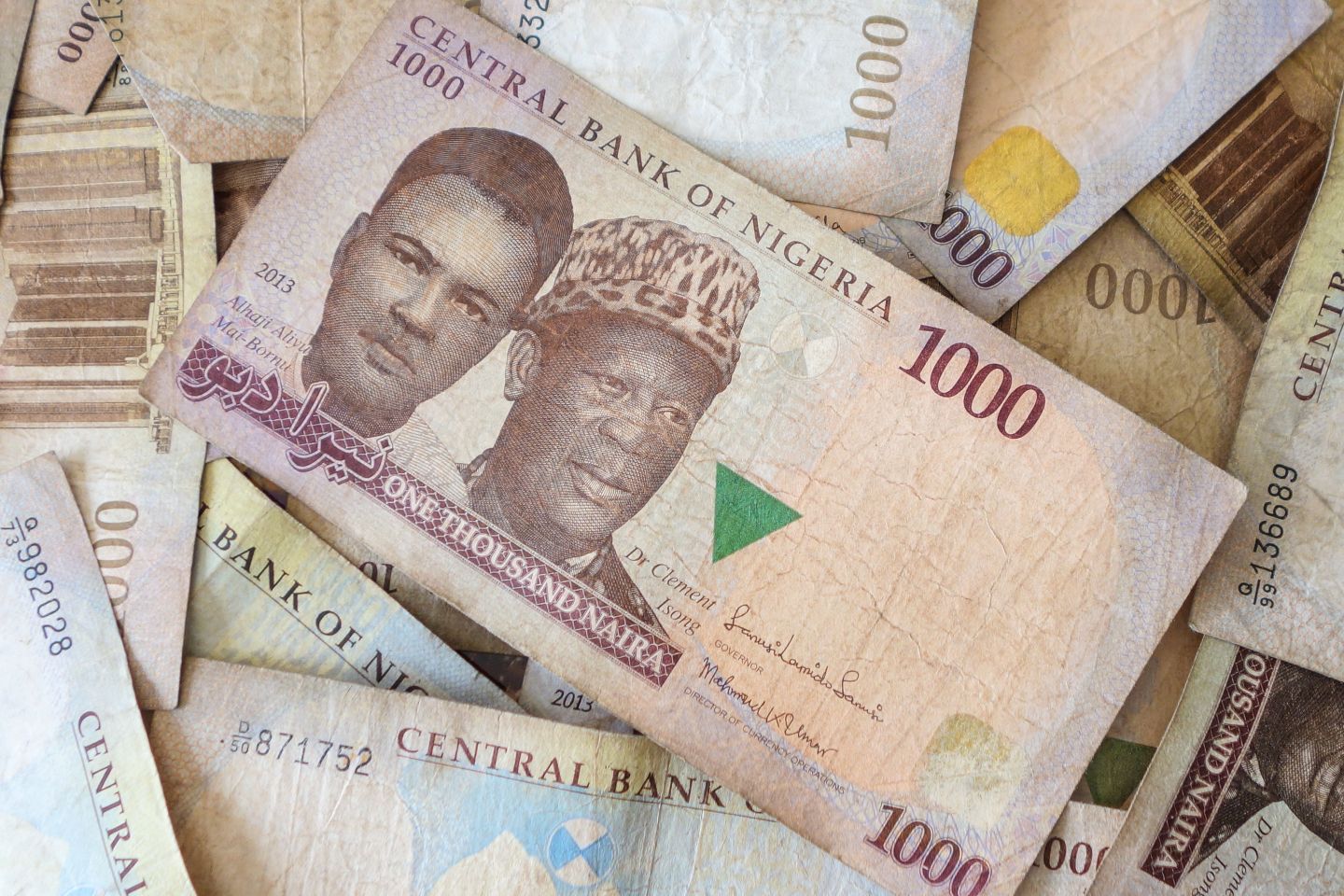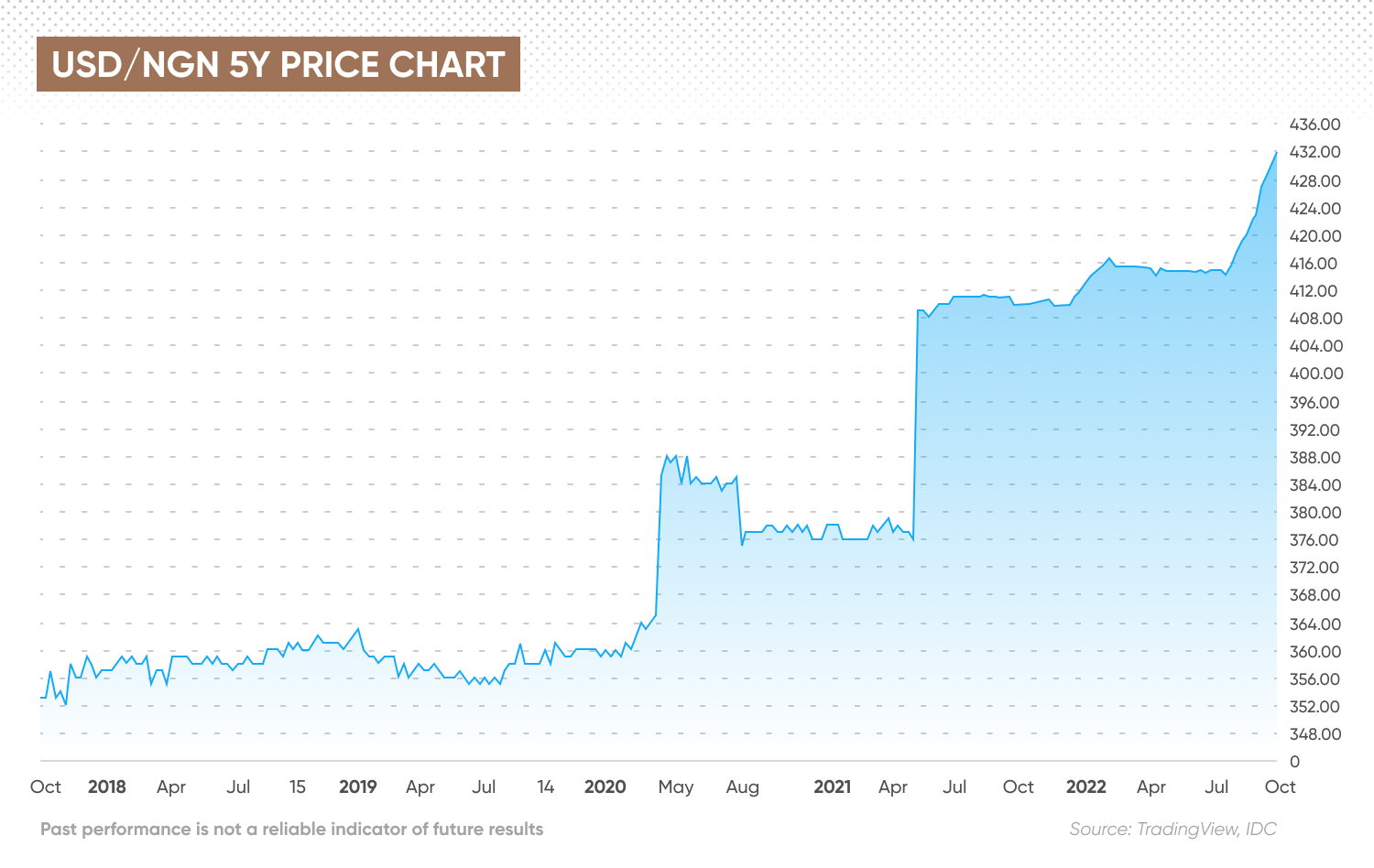USD/NGN forecast: Nigerian naira faces lengthy struggle as oil revenues decline
The Nigerian naira has fallen 25% against the US dollar this year on low oil output. What lies ahead for the currency? Read on in our latest USD/NGN forecast round-up.
The Nigerian naira (NGN) has fallen 25% against the US dollar (USD) this year, hitting a new record low.
In this article, we look at what has contributed to the naira selloff, along with the latest USD/NGN forecasts.
How has the Nigerian naira performed so far in 2022?
At the start of this year, the Nigerian naira was trading at 412 NGN to 1 USD. The pair rose modestly across the first 6 weeks of the year, rising to 416 on February 14, before easing back to around 415-414, where it traded across the next five months.
In August, the naira started weakening significantly, lifting USD/NGN to 422 by the start of September. The naira fell to an all-time low of 435 NGN to 1 USD on September 29.
What is the Nigerian naira, and what moves it?
The Nigerian naira (currency code: NGN) is the official currency of the Federal Republic of Nigeria, replacing the British pound in 1973. At that time, the conversion was set at two naira for every one pound. However, owing to inflation, the naira devalued. As of today, the USD is the most popular foreign exchange pair with the naira.
The Central Bank of Nigeria (CBN) is responsible for the management and distribution of the naira, controlling circulation while also trying to keep prices stable.
Oil and gas are critical to the Nigerian economy, with oil accounting for around 40% of Nigeria’s GDP and 80% of foreign exchange earnings. In fact, Nigeria’s dependence on oil is considerably larger than that of most other significant oil-producing nations. This means that fluctuations in the price of oil and oil production levels are a significant influence on the health of the Nigerian economy, the level of foreign reserves, and ultimately the value of the national currency.
Foreign reserves are important as they are the assets held by a central bank that help to keep the value of the domestic currency steady, maintain liquidity and provide confidence for investors. Reserves are also needed to pay external debts. When foreign exchange reserves fall, the impact on a currency, particularly an emerging market currency, can be substantial.
Finally the economic health of a country, its rate of inflation and policy interventions by the central bank, can also influence the price movement of the naira.
USD/NGN historical rate performance
A decade ago, at the start of 2012, USD/NGN was trading at 158.35, remaining roughly at that level until October 2014.
By February 2015, the currency pair had weakened further to 197, and then on June 1, 2016, the naira tumbled to 283. From there, the currency continued to weaken.
USD/NGN rose to 363 by August 2017 and continued to trade at similar levels until May 2021, when the naira devalued again to over 400. Since May last year, the naira has fallen from record low to record low.

Latest developments: Oil production tumbles
The Nigerian naira has fallen to a record low against the US dollar as foreign exchange inflows and reserves fall amid declining oil production.
Foreign exchange inflows into Nigeria fell 2.4% to $1.5bn in the three months to June compared to the previous quarter despite oil prices rising. This suggests that the fall could be due to reduced production.
Nigeria’s oil production has declined significantly, falling to its lowest level in over 25 years in August 2022 as output dropped to 1.18 million barrels. Furthermore, according to Organisation of Petroleum Exporting Countries (OPEC) figures cited by Al Jazeera in early September, Angola and Libya had surpassed Nigeria as Africa’s highest oil producers.
Underinvestment and chronic infrastructure issues have plagued Nigeria’s oil sector, meaning exploration and development of fields are drying up, and production has fallen to a multi-decade low. Big names such as Shell and Exxon have announced divestment plans in Nigeria. Theft has also been a huge problem, with an estimated 400,000 barrels per day disappearing.
In the most recent quarter in July – September period, not only has Nigeria experienced lower output, but the price of oil has also fallen considerably over the past few months, hurting foreign exchange inflows and reserves.
Oil prices have tumbled 35% from the recent June highs as central banks across the globe have hiked interest rates to tame soaring inflation, slowing global growth and hurting the oil demand outlook. The International Energy Agency (IEA) now expects oil demand to fall for the first time this year since 1990, while investment bank Goldman Sachs (GS) has also cut their oil price outlook.
Scarcity of dollars
The CBN has expressed concern over the declining value of the naira and is attempting to avert further downside. Part of the problem also relates to a scarcity of dollars. In July 2021, the central bank halted forex sales to retail currency traders to cool pressure on reserves and support the official market. Instead, it pushed demand to the unofficial market, where the naira trades freely at close to a 50% premium.
Inflation
Like many other countries, Nigeria is experiencing multi-decade high inflation. Nigeria’s inflation rate rose to 20.52% in August – its highest level since 2005.
The Central Bank of Nigeria’s monetary policy committee raised its interest rate again in September as it continues to struggle in its fight against inflation. The MPC hiked the key interest rate by 150 basis points to 15.5%, marking its third rate increase since May, when the rate was 11.5%.
Central Bank governor Godwin Emefiele said there could be more hikes to come and it was “imperative” to bring inflation down.
USD/NGN forecast: 2022 and beyond
According to Nigeria’s minister of finance, Zainab Ahmed, the naira could devalue further. Speaking in an interview, she said the further weakening “will happen with time”, without giving a specific timeline. Ahmed also said that Nigeria would not take on an International Monetary Fund (IMF) program to address Nigeria’s fiscal challenges.
Head of Africa strategy at Standard Chartered Bank, Samir Gadio, said he believes it unlikely that the government would adjust the official rate before the coming presidential elections in February.
As of 4 October, according to analysts at TradingEconomics, the naira was expected to continue weakening. It forecast that USD/NGN could be at 432.73 by the end of the quarter and 435.33 in 12 months.
The USD/NGN forecast from algorithm-based forecaster WalletInvestor also predicted the Nigerian currency could weaken in the near term, with USD/DBT ending 2022 at 436.41. In the longer term, its USD/NGN forecast for 2025 saw the rate rising to 500.44 by the end of the year.
Wallet Investor’s USD/NGN prediction for 2027 saw the pair rising to 538.83. Continuing with this trend, the USD/NGN forecast for 2030 could potentially be higher still. However, at the time of writing (4 October), no services offered a forecast that far into the future.
It is important to remember that analysts’ and algorithm-based USD/NGN forecasts can be wrong. Always conduct your own due diligence before trading, looking at the latest news, technical and fundamental analysis, and analyst commentary.
Past performance does not guarantee future returns. And never trade money that you cannot afford to lose.
FAQs
Why has USD/NGN been dropping?
The Nigerian naira has fallen sharply amid growing economic headwinds in the country, including the deteriorating performance of its oil sector. The sector, which is responsible for 80% of its foreign currency, has suffered from under-investment and theft on a huge scale. Dollar scarcity has added to the problems.
Will USD/NGN go up or down?
According to forecasts from analysts and algorithm-based prediction platforms, the outlook for the USD/NGN is bleak. AI-based services predict that the Nigerian naira will continue dropping in value against the US dollar.
Remember that analysts and forecast websites can be wrong in their predictions. Always do your own research. And never invest more than you can afford to lose.
When is the best time to trade USD/NGN?
The best time to trade USD/NGN is usually between 10am and 5pm GMT, particularly when both the London and New York markets are open as this should be when liquidity is at its highest.
Is USD/NGN a buy, sell or hold?
Only you can decide what the right choice is for you concerning USD/NGN. Remember to do your research, considering each country's economic outlook, GDP, imports, exports, inflation data and foreign exchange reserves. Never invest money you cannot afford to lose.